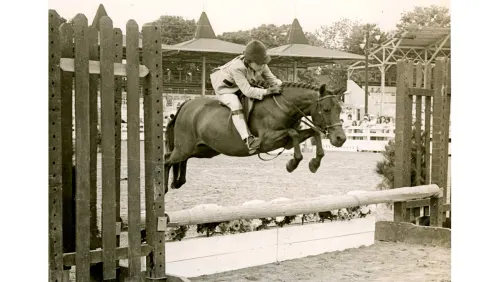Wellington, Fla.—Jan. 6
If you thought flatwork would be contained in Thursday’s flat lessons, think again. Before Olympic veteran Beezie Madden began her gymnastic work demonstration on Friday at the George Morris Horsemastership Clinic, she took a moment to remind everyone that all jumping stems from great flat work.
“I want to feel, whether I’m galloping or I’m counter cantering or I’m collected, like I could jump a big fence with this canter,” Madden said. “That’s the goal of our flat work.”
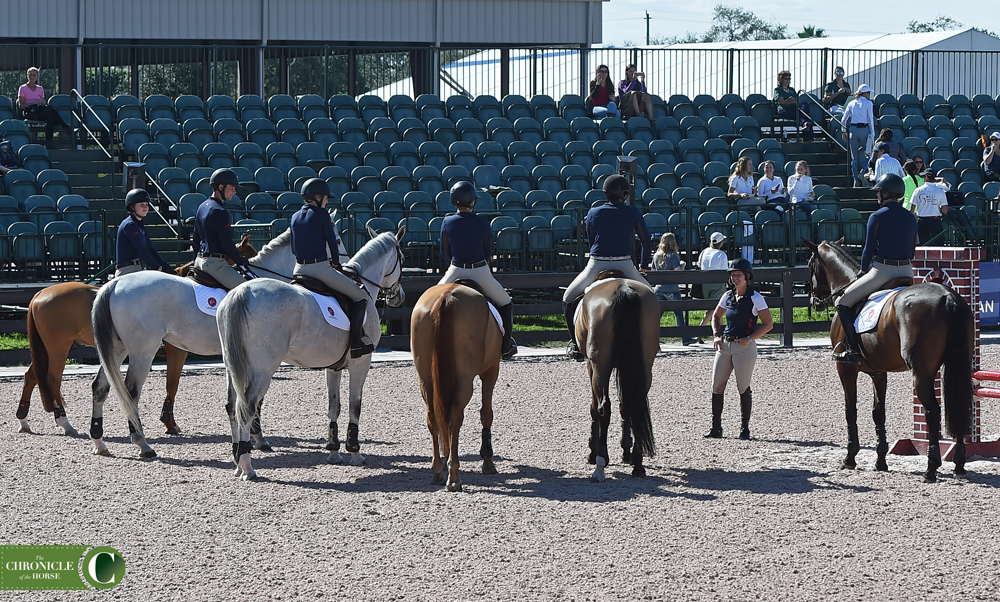
Beezie Madden gathered riders around to discuss their horses before the start of each session. Photo by Ann Glavan.
Madden started her gymnastic demonstration ride with Breitling LS by putting him through his paces, asking him for a shoulder in at the trot while explaining to students and auditors what she does to fix Breitling’s weaknesses, particularly a falling left shoulder.
“Throw your own shoulder to the left, and try to turn your head left. It’s hard!” Madden said. “Now put your shoulder a little right and look left, it’s a lot easier. You can’t have a horse properly bent if he’s throwing his shoulder to the inside.
“You guys may not remember but I remember, I lost two grand prixes in Florida last year from a vertical on a left to right angle because he throws that shoulder,” Madden said with a chuckle.

Beezie Madden jumps Breilting after spending time correcting his left shoulder on the flat. Photo by Ann Glavan.
After some trot work focusing on that correction, Madden picked up a canter and let Breitling take a little break from his collected work and simply move out around the ring. Then she started working on collecting him back and sending him forward, emphasizing the same thing Anne Kursinski did in her flat lesson the day prior: that the power, the energy, and everything we need from the horse starts in the hind leg.
“I’m no dressage rider and he’s no dressage horse but watch what I can do with an active horse,” she said.
Indeed, one of the most impressive moments of the entire day was when Madden then turned Breitling up the diagonal line and did a series of eight or nine three tempi flying changes all the way to the other end of the ring.
“That’s because his hind end is engaged, if his hind end isn’t engaged I can’t get that,” Madden said.
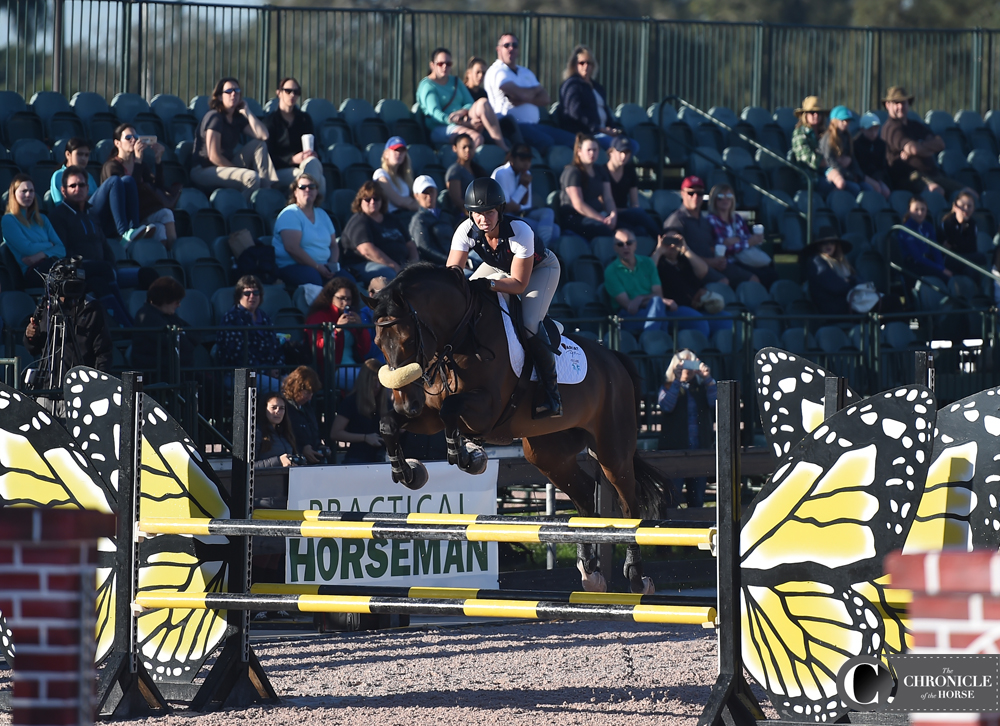
Auditors watch as Beezie Madden guides Breitling through a gymanstic line. Photo by Ann Glavan.
From The Ground Up
After her brief warm up on the flat, Madden took Breitling over a series of three ground poles, each 45 feet apart. Madden described the distance in between the poles as a hunter three strides, and for the first few times down them she did three and three strides.
“I want to show you how adjustable your horse needs to be on a straight line,” Madden said. She then came down the line and did three and four strides between the two poles, and an even tighter three to five strides, finishing with Breitling sitting down like a rocking horse to do a three to a six, double the amount of strides it walked.
Madden didn’t ask her students to try and fit six strides in the poles, but she did have them do the three to the five, as well as a number of other creative variations, like trot the first pole, walk the second, trot the third, or canter the first, sitting trot over the second, canter the third.
ADVERTISEMENT

Beezie Madden helps Coco Fath from the ground to help her horse understand the haunches out on a circle. Photo by Ann Glavan.
For Madden, the exercise was about adjustability, the rider’s position and effectiveness and their connection with the horse. Rider’s with a less steady connection or a weak position struggled to make the transitions smoothly or at the proper time in the poles.
“Position is what’s important here, show me a closed hip angle in the three and an open hip angle in the five stride,” Madden said. She was particularly tough on riders with strong horses, emphasizing that their position would be even more important in maintaining control over the situation.
Madden demonstrated on rider Taylor St. Jacques, taking hold of her horse’s reins and having her collapse forward from the hip before delivering a firm tug on the reins and showing how easy it was to pull St. Jacques out of the tack.
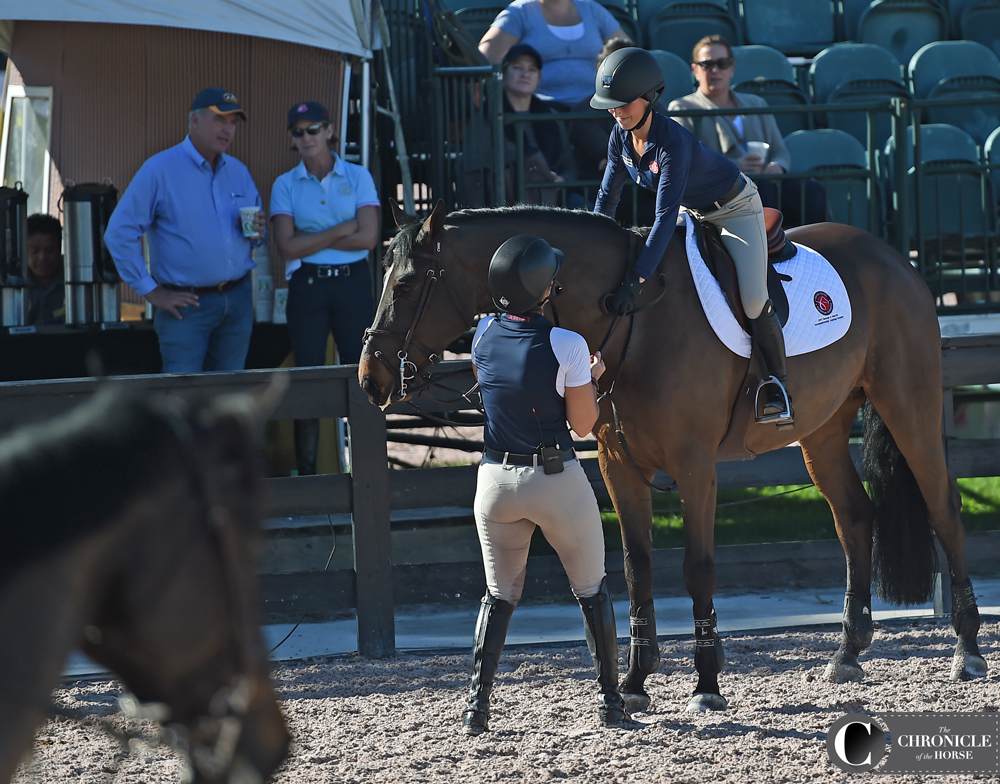
Beezie Madden demonstrates how easy it is to get pulled out of the tack if you collapse from the hip. Photo by Ann Glavan.
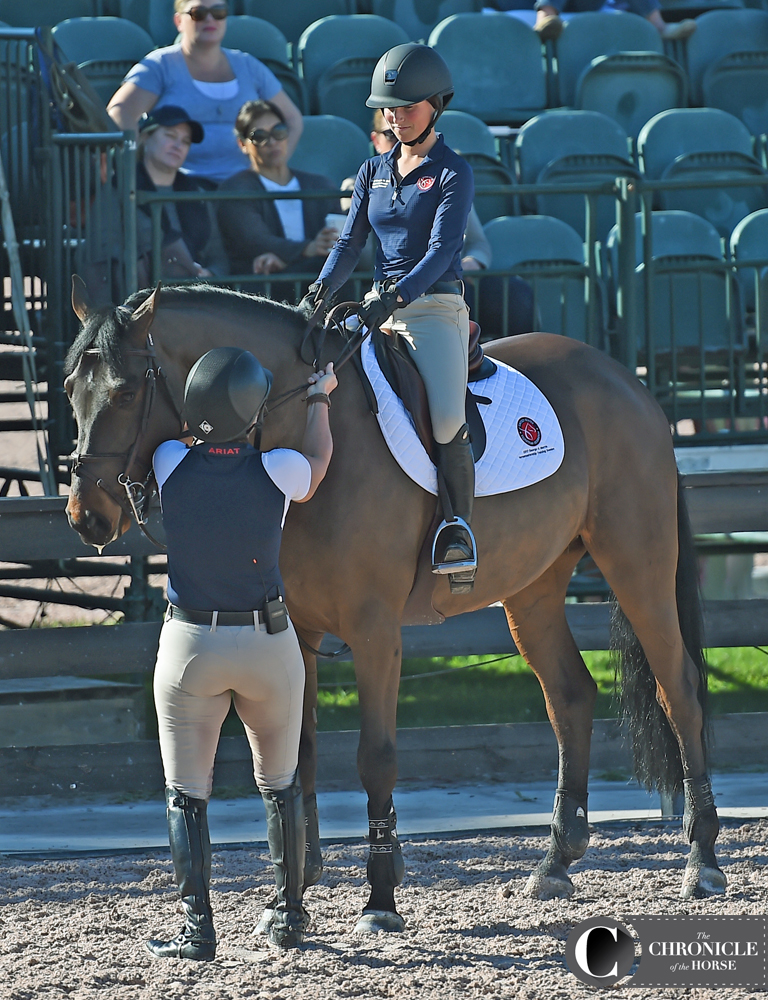
That’s more like it! Beezie Madden has rider Taylor St. Jacques demonstrate the correct position to have with a strong, pulling horse. Photo by Ann Glavan.
“And I’m not even a big strong horse!” Madden said.
Then she had St. Jacques pull her shoulders back and behind her hips, and St. Jacques was able to resist Madden’s tugging.
“You guys with roached backs, you have to use lots of arms to compensate, and you can get away with that because your big strong guys,” Madden said. “But you’re stronger and you’re softer if you bring your shoulders back behind your hips to bring the horse back.”
One of the variations of the pole exercise Madden asked riders to do involved a halt before the final pole, and when Michael Williamson’s horse resisted stopping and ended up straddling the pole, Madden came up with a new test for rider accuracy.
“Michael’s horse just gave me an idea,” Madden said with a grin. “Canter the three, halt, then walk and halt with their front feet in front of the [last] pole, back feet behind it.
“This is good because you have to keep the connection,” Madden continued. “You have to maintain the very delicate balance between hand and leg, and the horse has to work on his patience.”
Some riders struggled with the exercise, including its inventor Williamson’s horse—the pair elicited laughs from both Madden and the crowd when he dramatically crow-hopped in front of the last pole before slamming his front feet down on the opposite side. Getting it done with a bit of sass!
“I could make a whole day out of those rails on the ground, but we have other things to do,” Madden said.
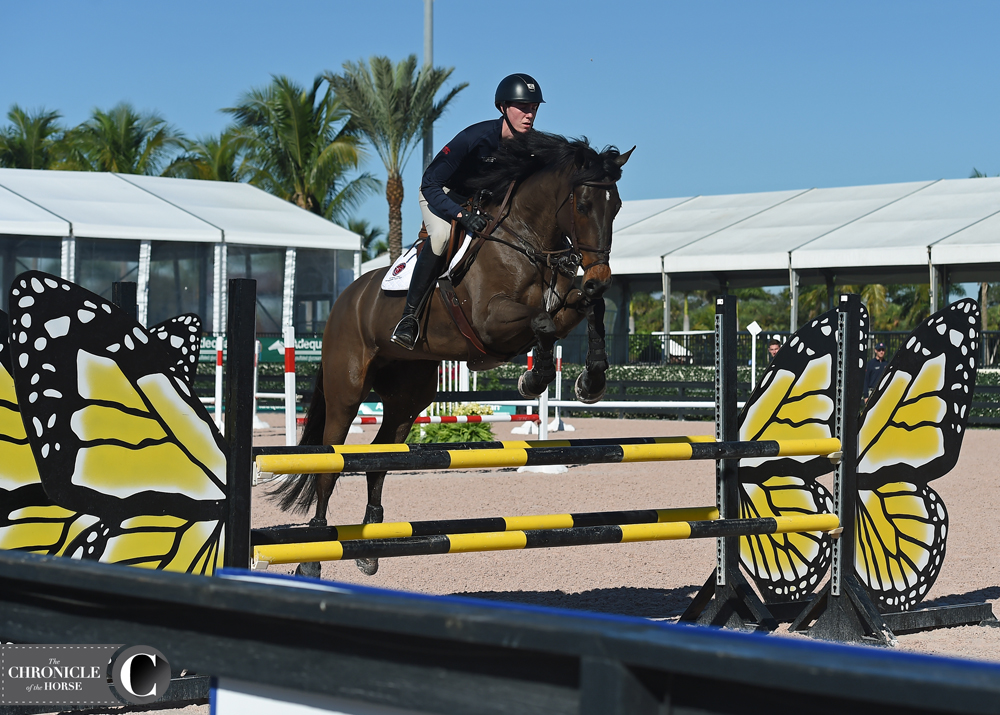
T.J. O’Mara negotiates a gymnastic line. Photo by Ann Glavan.
Let The Horse Figure It Out
Madden set up two gymnastic jumping lines down the long side of the arena—four jumps set 60, 45 and 60 feet apart, and four jumps set 23, 36 and 48 feet apart. Madden also incorporated the series of three small verticals set on a C-shape at the end of the ring and two water obstacles—and open water, and a ramped oxer with a dug in Liverpool beneath it.
Because almost every jump was set squarely off the wall or corner, Madden was adamant riders keep proper pace in the approach and not let their horses lose rhythm as they turned toward an exercise.
ADVERTISEMENT
“Most horses like to make a little bid, or learn to make a little bid at the fences because you don’t carry enough pace through the corner,” Madden said. “Carry a little pace now so you can settle to the fence. Wait for the jump to come to you.”
Some of the distances between different jumps were deliberately set a little long or a little short to challenge both sides of the horse’s adjustability.

Taylor St. Jacques jumps the training liverpool. Photo by Ann Glavan.
“Horses are all different, Maddie [Goetzmann] and Cooper [Dean’s] horses are small and super clever, so the galloping distances are hard for them, but they have to practice it,” Madden said. “The bigger horses have a harder time with the small distances.”
After making sure everyone’s horse could jump the open water, Madden had riders bend directly from the open water to the C-shaped gymnastic, a roughly 8-stride bending line but not set for any particular stride. More than one rider had a fly by moment when they were unable to bring their horse back after opening up for the water, and that was precisely the point.
“That’s the trick course designers always do, something tricky after the water,” Madden said.
While Madden wanted riders to work to get their horse back after the water, once they were in the gymnastic, she reminded them over and over again to leave the horse alone.
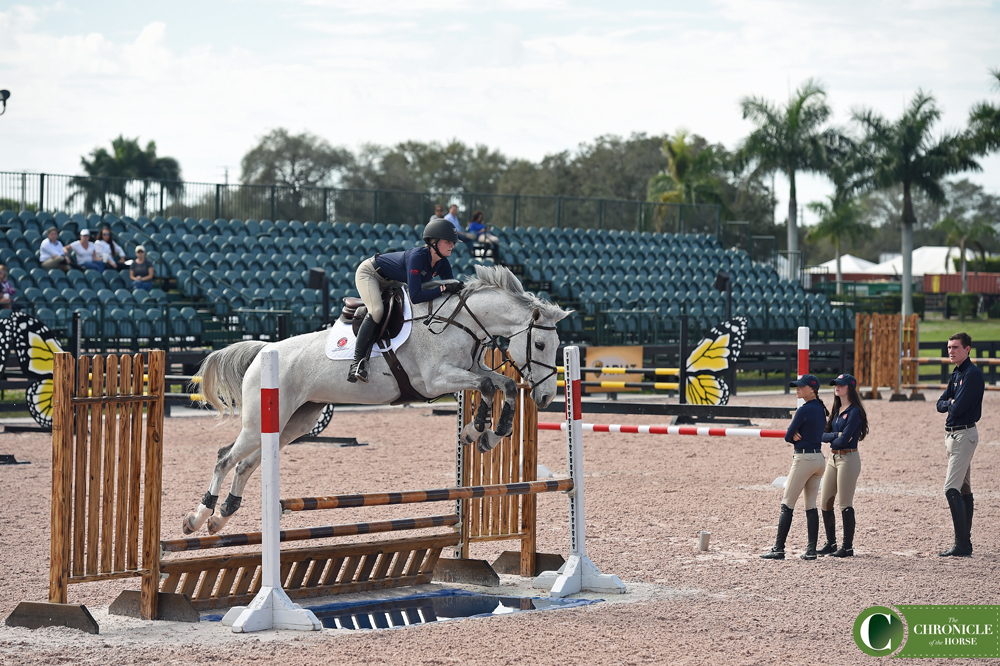
Caroline Dance pops over the dug in liverpool, one of three water obstacles stackled throughout the day. Photo by Ann Glavan.
“Don’t help them in that gymnastic; I like to let the gymnastic do the work,” Madden said.
Coco Fath had a large, energetic horse who was struggling to come back and fit in the one stride for the C-shaped gymnastic, and Madden had her change up the feel on her horse’s mouth to get the exercise done more smoothly.
“I call that a guiding rein, you were trying to hold him and force him, but then when you instead guided him and let him use his own eye a bit, he used his back better through the exercise,” Madden said.
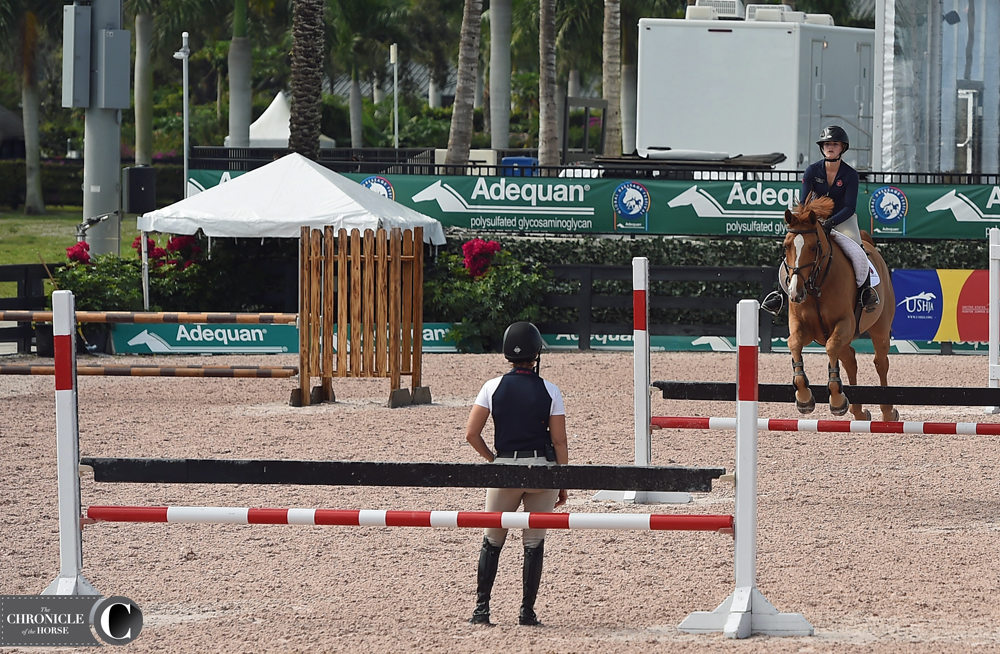
Don’t run over that Olympian! Beezie Madden used herself as a block to help Halie Robinson halt her strong horse in the middle of a line. Photo by Ann Glavan.
At the end of each gymnastic line, Madden almost always asked riders to halt their horses, using the fence if need be, and she was very adamant horses were not to take backwards steps in the halt.
“Leg him forward if he does that,” Madden instructed. “But don’t then ask them to halt again right away, let them take a forward step or two, because that’s what your leg means, go forward.
“Try to think whenever you’re working with horses, is she frustrated because she confused?” Madden continued. “Be very clear with what you want.”
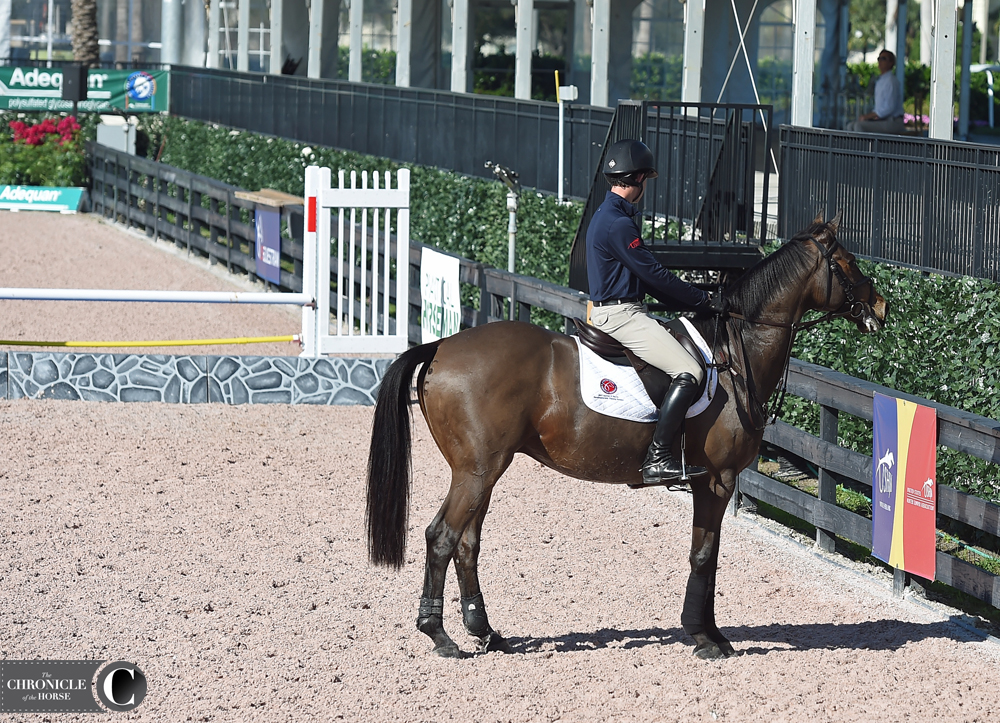
Cooper Dean halts his horse after an excercise. Photo by Ann Glavan.
Check back with the Chronicle on Jan. 7 for more coverage from the USEF George H. Morris Horsemastership clinic, and don’t forget to check out the Jan. 23 issue of the magazine for more in-depth analysis from the clinic. A schedule of the clinic can be found here and you can find live streaming from USEF Network here.







